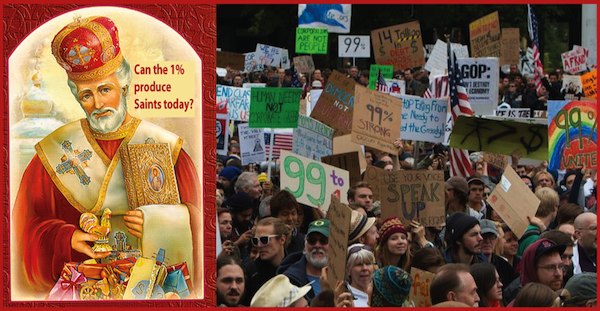December 7, 2011

St. Nicholas’ charity work was made possible thanks to the wealth of his parents which he inherited at a young age when they died. Eugene Peterson in an essay titled “God with us: Rediscovering the Meaning of Christmas” summarizes the story of “the Saint of the One Percent.”
Today we remember Saint Nicholas, who was the Bishop of Myra in the province of Lycia during the fourth century. Very little is known about his life, but he is remembered as a man of great faith and compassion. He was also a fierce advocate for those who had been unjustly condemned. But he left behind no writings: the legends surrounding his life are all we have. Nicholas is most well known in the West as the beloved patron saint of children and gift-giving. His connection to the American character of Santa Claus is faint, but it can be traced. According to tradition, Nicholas’ parents died when he was young, leaving him a large sum of money. With his inheritance, Nicholas practiced charity, helping those in need.
Connection to Santa Claus:
One legend in particular illustrates his generosity: a
family in his community was desperate; the father had lost
all of his money and had been unable to find husbands for
his three daughters. The daughters were in danger of being
given over to prostitution or another form of degradation
when, one night, Nicholas appeared at their home. He
tossed three bags of gold into the open window (or down
the chimney, in some versions)—thereby saving them
from a terrible fate. This tale is probably the source of
his eventual connection to the tradition of gift giving at
Christmas. The custom of giving gifts on Saint
Nicholas’ feast day probably originated in Europe
among Protestants. The Reformation had led many
Protestants to all but abandon the remembrance of the
saints. But Saint Nicholas remained a popular figure,
especially among children, who received gifts in his name
on December 6. The custom spread with immigration to North
America when Dutch children told their English-speaking
friends about “Sinter Klaas,” the bishop in
red vestments who brought them surprises on his feast day.
The American History of mispronunciation—Santa Claus—eventually took on a life of its own. This jolly Saint Nick also delivered gifts through the chimney, but on Christmas rather than the saint’s day. He wore a red suit rather than liturgical vestments, though he still vaguely resembled the old depictions of Nicholas, which showed him with bald head and full beard.
Aside from the obvious disparities between Saint Nicholas and the secular Santa Claus, perhaps the most poignant difference between them can be seen in the nature of the gifts they give. While Santa has his bundle of toys, the gift that Saint Nicholas gives is nothing short of freedom from poverty and desperation.
The life of Saint Nicholas is an example of faith made
flesh in actions of true charity.
(From Eugene Peterson, “Feast of Saint Nicholas,
December 6,” GOD WITH US: Rediscovering the Meaning
of Christmas, edited by Greg Pennoyer & Gregory
Wolfe)
